#ROMAN GARNET INTAGLIO IN GOLD RING
Text



ROMAN GARNET INTAGLIO IN GOLD RING
Ca. 1-200 AD
#ROMAN GARNET INTAGLIO IN GOLD RING#Ca. 1-200 AD#gold#gold jewelry#roman jewelry#ancient jewelry#ancient artifacts#archeology#archeolgst#history#history news#ancient history#ancient culture#ancient civilizations#ancient rome#roman history#roman empire#roman art
739 notes
·
View notes
Text


Gold ring with garnet intaglio of Aesclepius, Roman, 1st-3rd century AD
from Apollo Art Auctions
745 notes
·
View notes
Photo



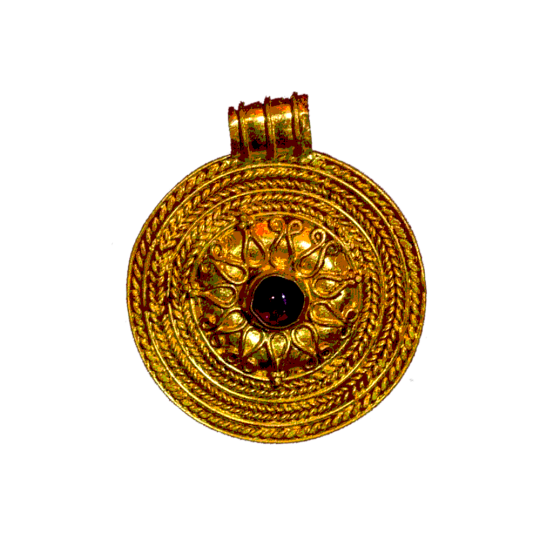





Gold treasures for Apollo
Myrtle Wreath / Roman Gold Ring with Intaglio of Apollo / Golden Bow
Roman Gold Sun Pendant / — / Roman Sun Worshipper Medallion
Golden Chariot / Scythian Gold Comb / Roman Gold Garnet Earrings
Museum & Auction finds linked. Edited by me.
34 notes
·
View notes
Text
I’ve been down a rabbit hole wondering about medieval jewelry (and if I can reproduce it despite having no metalworking skills, to which the answer is mostly no) lately & I figured I would share the fruits of my museum collection searches for other medievalists/hobbyists/reenactors/nerds.
Jewelry of the 13th Century Anglo/Francosphere

TL;DR
Metals: 🟨 gold(tone)
Stones: mostly 🔵 cabochon, rarely 💠 simple cut, some carved 🗿 intaglio or cameo
Stone Colors: warm blues, emerald green, purples, burgundies, reds
Materials: enamel, 💎 gemstones (garnet, Ceylon sapphire, ruby/spinel, emerald) or glass paste imitations, ⚪ semi-precious stones (pearl, lapis, jasper, carnelian, coral, turquoise, porphyry)
Settings: bezel (oval and rectangular); ⚜️ intricate metalwork; more visible and textured metal than modern jewelry; more mixtures of stones and colors than modern tastes
Motifs: ◯ round, ✤ quatrefoil, ✙ cross, ✸ star (even numbers of points), ♣ trefoil, ❦ floral, 🐉 animals, 𝕬 inscription
Formats: brooches, ornamented clothing, rings, pendants, circlets, cuffs (rare)
A detailed look:
Some forms of jewelry that were very popular in the Roman Empire and are again today were just not the thing in the middle European Middle Ages. (Earrings, for example, seem to have barely existed. This is partially at least because ears were covered--by coifs and caps, hair, and (for women) braids or the chin strap and fillet/wimple/gorget.) In fact, a lot of the places we would put jewelry against our skin today were covered.
This left some other options:
Jewelry on Clothing
Medallions
Okay, these aren’t jewelry, strictly speaking, but they’re metalwork ornaments associated with a person.
Enamel Mitre Medallions


OA 3437 and OA 3438
Before 1291, Ile de France
Louvre, Paris
photos (c) Musée du Louvre / Stéphane Maréchalle 2015
Cloisonné and plique enamel over gold and copper, with decorative motifs of trefoils, quatrefoil, and stars in a palette of dark blue and green with accents that may once have been ruby red.
Appliqué Medallion
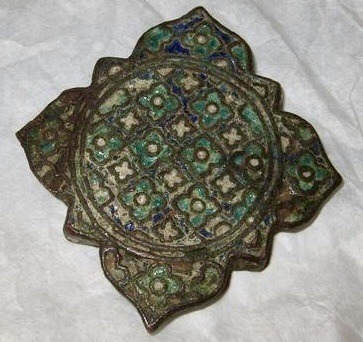
# MRR 256
13th c., Limoge
Louvre, Paris
photo (c) Musée du Louvre 2014
Gilded copper (though most gold is worn off) with quatrefoil champlevé enamel in emerald green, lapis blue, and white or off-white.
Brooches
Perhaps the most prevalent medieval jewelry item in the Anglo & French regions. These were worn at the shoulder for men and breast for women, often anchoring a cloak, or to close the collar. As the ornate fermail and double-ring brooch suggest, these ran the gamut from practical to incredibly decorative and ornate.
Garnet & Silver Gilt Animal Ring Brooch; Green and Blue Glass and Gilt Ring Brooch


Left, # 2003,0703.1
13th century; found in Suffolk, England
British Museum, London
photo (c) The Trustees of the British Museum
Right, # M.28-1929
13th c., England
V&A, London
photo © Victoria and Albert Museum, London
Cabochon garnets or carbuncles in the gilded silver brooch (L), perhaps once paired with smaller stones in the eyes of metalwork animals that bite the pin bracket. The right brooch, also silver gilt, sports two glass paste emerald and sapphire "gems" in cabochon. It was probably a lover's token; it reads (in Lombardic-lettered French) IOSV ICI ATI VCI or "jo su[i] ici a t[o]i v[o]ici" which I might translate as "I am here with/belonging to you, look!"
Ruby & Sapphire Ring Brooch; Sapphire, Garnet, and Pearl Fermail
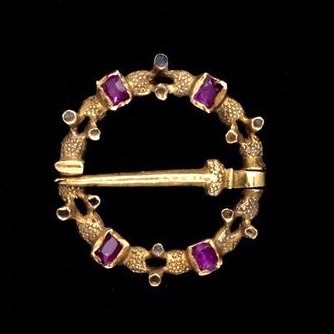
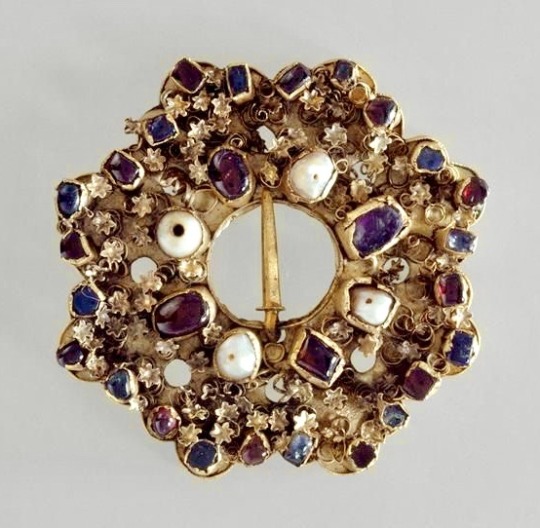
Left, # 6808-1860
1275-1300, England
V&A, London
photo © Victoria and Albert Museum, London
Right, # OA6287
1250-1300, France
Louvre, Paris
photo (c) Musée du Louvre
Blogs often claim that stones were only polished en cabochon until the 16th century, and that medieval jewelers couldn't cut gemstones. But this 13th-century gold ring brooch (left) pairs table-cut purple rubies with collet-set cabochon sapphires, and may evidence early medieval gem-cutting or reuse of Roman cut stones. The silver gilt fermail, right, includes pearl beads, garnets and sapphires both cut and cabbed, and one glass paste cabochon. Both are intricately textured, with punchwork (L) and floral metalwork, probably cast and then attached (R).
Double Ring Brooch with Sapphire and Glass "Emeralds"
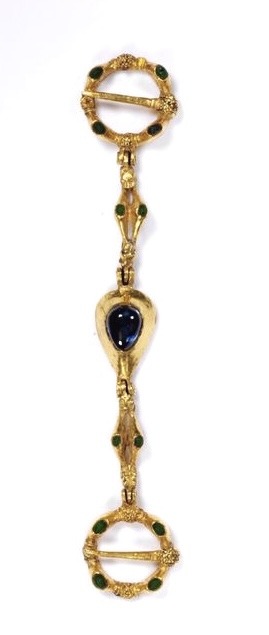
# M.26-1993
13th c., England
V&A, London
photo © Victoria and Albert Museum, London
This gold double brooch is so small they think it was for a woman or child. Central sapphire cab is flanked by glass paste "emeralds" in bezel settings and metalwork featuring two animal heads.
Jewelry on the Body
Rings
Many are probably familiar with the signet ring, used for pressing into sealing wax, which could be intaglio-carved gemstone or metals. There were also a number of decorative and/or talismanic gemstone rings.


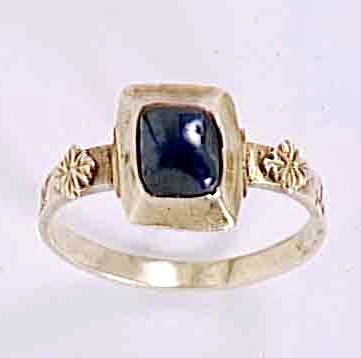
LtR:
#M.7-1929 | #M.180-1975 | #OA 11265
1250-1300, England | 1250-1300, Engl/France | 13th c., Engl/France
V&A, London | V&A, London | Louvre, France
photos L&C © Victoria and Albert Museum, London | R (c) Musée du Louvre
Sapphire in gold is the name of the game when it comes to rings in the thirteenth century; even the purple stones on the left are purple sapphires. (Sapphires were said to aid chastity, purity, and the effectiveness of prayer.) For larger stones, the bezel often has claws added (L); the central ring is an example of a full claw setting that modern viewers might find surprisingly tall. Naturalistic flourishes are added (C & R); these might be pre-cast then attached to the base (R).
Pendants
We equate pendants with necklaces, but their medieval applications also included wear as badges, from headpieces, and on horse decorations.


Left, bloodstone jasper cameo in silver setting
# MRR 218
1100-1300, France?
Louvre, Paris
photo (c) Musée du Louvre / Jean Blot 1984
Right, champlevé enamel, gilt copper, and paste "emerald" (harness) pendant
# 1976.169
13th c., France
Cleveland Museum of Art, Cleveland
photo CC0 Open Access
Statue Jewelry
From here, we get into the really ridiculous stuff; the previous categories could be relatively everyday (as much as ornamentation reserved exclusively for the wealthy can be an everyday thing) but the following examples are astonishing displays not necessarily for wear.
"La Couronne" de Vierge et l'Enfant d'ivoire de la Sainte-Chapelle

# OA 57 B
1250-1300, France
Louvre, Paris
photo (c) Musée de Louvre
This was not even a crown for a person, but rather for a painted ivory statue of the Virgin Mary, holding her infant son. (Though circlets, even set with stones, were sometimes worn as part of women's head dress.) It's incredibly ornate gold, set with pearls, garnets and rubies, sapphires, and turquoise (?) en cabochon.
Anneau de Saint-Denis




# MS 85 BIS
1200-1215, France
Louvre, Paris
photos (c) Musée du Louvre / Daniel Arnaudet 1990
This astonishing piece, which is ring-sized but now displayed as a cuff on an ivory hand, is made of gold and displays every possible gemstone appearance characteristic of the period. The front piece has a central sapphire and is surrounded by quartz with red backing (mimicking ruby/garnet), amethysts, pearls, and sapphires, some set on yellow backing (mimicking turquoise?). Most are en cabochon on this face, but two are faceted and two intaglio. Were this not enough, the three other 'faces' of the ring are set with gems as well, two cameos (probably sapphire and garnet?) and one amethyst intaglio set in ornate gold filigree.
#medieval#jewelry making#lapidary#history of fashion#historical jewelry#1200s#reenactment#England#France#enamel jewelry#ring brooch#fermail#intaglio#cameo#gemstones#infodumping#now time to go to the bead store#material history#you would think this is for my research or academically relevant but it's not I just couldn't stop looking at shiny things help#photos not mine#photos for educational purposes and not for commercial reproduction#louvre#v&a museum#british museum#cleveland museum of art
33 notes
·
View notes
Photo
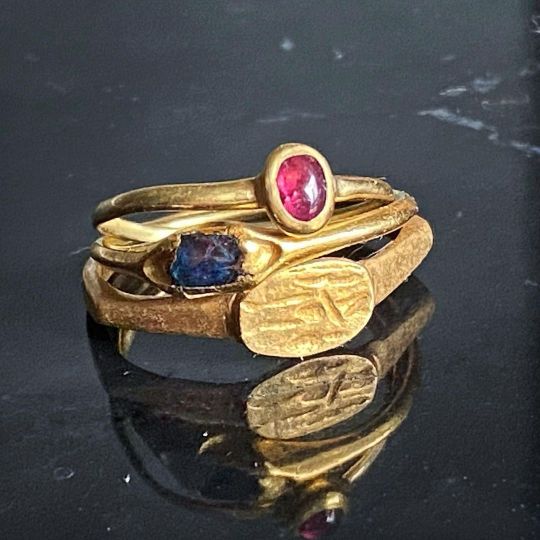
The Ancients.... the 3 oldest rings in my collection. A gold Roman ring dating from the 3rd century AD feature an intaglio of Sol, the Sun god. A 14th/15th century ring featuring a sapphire in a cupped setting. During the middle ages, sapphire was believed to shield the wearer from harm and disease and was used as an antidote to poison. A 13th/14th century ring featuring a garnet in a simple pie-crust, rubbed over bezel, typically worn of lower nobility. Bottom two are personal - top garnet ring is available. Tap the link for all the details, including garnet lore and pricing. . . . . . . . #medievalring #medievalgarnetring #medievaljewelry #heirloomjewelry #antiquejewellery #rarejewelry #stackingring #antiquejewelryobsession #neverenoughrings #antiquerings #amulet #ringcollector #antiqueringcollector #antiqueobsessed #magick #antiqueobsession #historicaljewelry #medievalera #magicaljewelry #showmeyourrings #ringsofinstagram #medievaljewellery #garnets #romanjewelry #antiquesofinstagram #garnetjewelry #romanring #blackumbrellaantiques #blackumbrellajewelry https://www.instagram.com/p/Cl6SM-YOqmt/?igshid=NGJjMDIxMWI=
#medievalring#medievalgarnetring#medievaljewelry#heirloomjewelry#antiquejewellery#rarejewelry#stackingring#antiquejewelryobsession#neverenoughrings#antiquerings#amulet#ringcollector#antiqueringcollector#antiqueobsessed#magick#antiqueobsession#historicaljewelry#medievalera#magicaljewelry#showmeyourrings#ringsofinstagram#medievaljewellery#garnets#romanjewelry#antiquesofinstagram#garnetjewelry#romanring#blackumbrellaantiques#blackumbrellajewelry
1 note
·
View note
Photo


A hellenistic gold ring set with a garnet intaglio with a roman vessel (if one interprets a ram at the bow that is it a warship, if not then it is a merchant vessel) of the 2nd - 1st century B.C.
409 notes
·
View notes
Photo
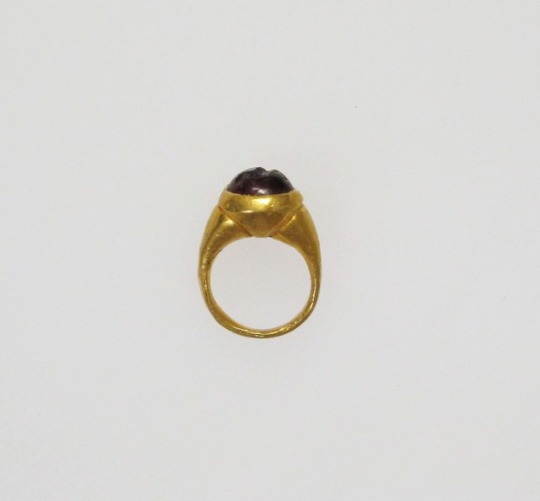
Ring with intaglio of a bird via Greek and Roman Art
Medium: Gold, garnet
Gift of Leon Farber, 1992 Metropolitan Museum of Art, New York, NY
http://www.metmuseum.org/art/collection/search/256145
0 notes
Text

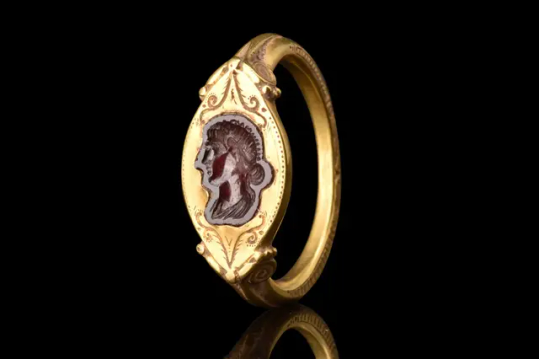
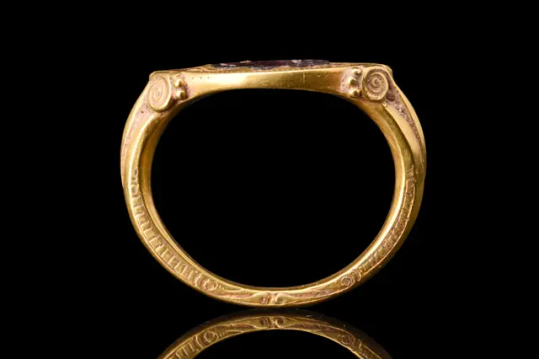
ROMAN GOLD RING WITH GARNET INTAGLIO WITH FAUSTINA JUNIOR
Ca. late 2nd century AD.
#ROMAN GOLD RING WITH GARNET INTAGLIO WITH FAUSTINA JUNIOR#Ca. late 2nd century AD#gold#gold jewelry#roman gold jewelry#ancient artifacts#archeology#archeolgst#history#history news#ancient history#ancient culture#ancient civilizations#ancient rome#roman history#roman empire#roman art
579 notes
·
View notes
Text

Gold ring with garnet intaglio, Roman, 1st century BC
from Bertolami Fine Arts
436 notes
·
View notes